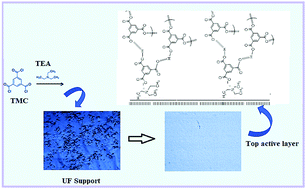Boron selective thin film composite nanofiltration membrane fabricated via a self-assembled trimesic acid layer at a liquid–liquid interface on an ultrafiltration support†
Abstract
A simple approach is demonstrated for the preparation of a charged active layer of a thin film composite nanofiltration (TFC-NF) membrane using two liquid phases (triethylamine, TEA, and trimesoyl chloride, TMC) over an ultrafiltration support. The thickness of the active layer formed can be varied in the range of 100–500 nm by varying the composition of TEA (0.25–1.5 wt%) while maintaining a fixed composition of TMC at 0.1 wt%. The chemistry of the active layer was confirmed using Fourier-transform infrared spectroscopy and nuclear magnetic resonance spectroscopy. Further morphological and physical properties of the TFC-NF membrane were characterized using field emission scanning electron microscopy, atomic force microscopy, a zeta potential analyzer, a contact angle goniometer, and molecular weight cut-off studies. The membrane chemical stability was proven over a wide pH range of 3–12. The membrane surface showed the highest negative charge compared to any of the commercially available NF membranes. The permeability of the TFC-NF membrane to seawater was 1.4 L m−2 h−1 bar−1 with a greater rejection of monovalent ions than any of the commercially available NF membranes. Remarkably, the TFC membrane showed a high selectivity towards seawater boron separation with a rejection value of 40% at seawater pH, which is approximately three times higher than the best tight layered commercially available NF90 membrane.



 Please wait while we load your content...
Please wait while we load your content...